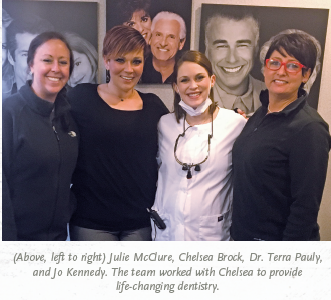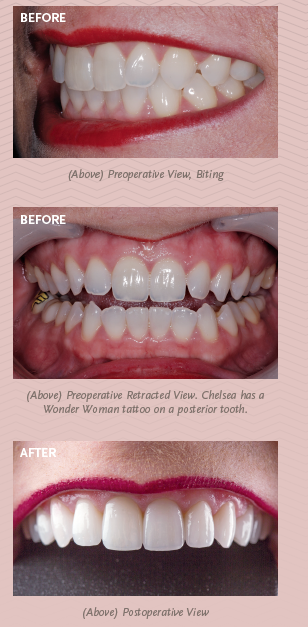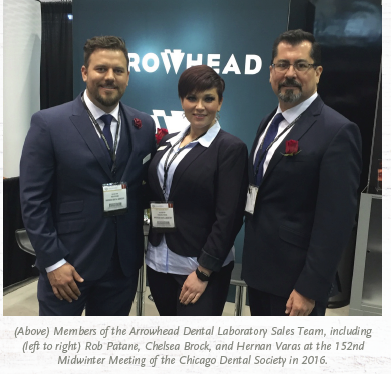
A Young Mom Gets a Full Arch Reconstruction.
As I was growing up, I always liked my smile. I never thought I had any problems. My teeth were straight except for tooth number 10, which was a little crooked. It looked a little bit like a snaggletooth, but it had personality, so I was fine with it.
None of my dentists ever discussed putting me in braces or indicated that I had any problems with my bite. But when I was in junior high, I started getting headaches. Doctors said that I had migraines and they prescribed medications for me that made me either drowsy or sick to my stomach. Instead of taking the medication, I just learned to live with the daily pain.
The headaches started getting worse in my mid-20s. I assumed that the cause for the headaches was just stress related, because I had newborn twins and I was working full time.
At the time, I worked for a dentist in Roosevelt, UT, which is a small town in northeastern Utah with about 6,000 people. The practice I worked for utilized lots of advanced technology.
The dentist did all kinds of tests and scans on me and he concluded that my grinding and clenching caused my headaches. As part of my treatment, I received a night guard, but I’d always pull it out in the middle of the night. I tried wearing the night guard during the day because I could feel myself clenching my teeth, but the headaches remained.
I then visited my primary care physician for advice, but he told me the same thing that I heard when I was younger, and I still experienced unwanted side effects with the prescription medication.
About the same time, I began having dental problems. Constantly clenching my teeth caused stress to my bite and I started getting abfractions along the gumline. I needed several root canals, and one of them went awry, so I had to get an implant when I was just 24 years old.
While all of this was happening, I was juggling the responsibilities of my job and three small children. Sometimes the headaches were so bad that I had to tell my kids, “Mommy just needs to lie down for a minute. I just need some quiet time.” Although they were young, the kids were great about trying to understand.

A NEW BEGINNING
Several years later, I divorced and moved to the Salt Lake City, UT, area. I focused on getting my kids settled in a new area and finding a new job. I decided I was ready for a change and didn’t want to be a dental assistant anymore. As a dental assistant in Roosevelt, I had worked with Arrowhead Dental Laboratory for about six years and I knew that Arrowhead was a great lab, so I applied for a job there and was hired.
Today, I am a sales representative for Arrowhead. I’ve been in this position since April 2016. However, I’ve worked for the company since December 2013. I started out in quality control, worked as a doctor relations rep, and eventually moved into sales. I love my current responsibilities and working with dentists.
During my first year at Arrowhead, Peggy Nelson (Director of Sales for Arrowhead) was looking for someone who had any TMD concerns to volunteer as a patient for a continuing education course, so I volunteered. During the course, the doctor said that I had hypertension in my jaw, and he gave me trigger-point injections to see if they would release the muscles. They provided a short-term pain solution, but nothing permanent. After the treatments, my jaw wasn’t as tight as usual but it still hurt.

We had no idea the problem was my bite. My jaw didn’t lock or click (which are typical TMD symptoms), it was just tense and very tight. No one ever addressed the problems with my bite, not even an orthodontist I consulted.
One day, a Tekscan representative visited Arrowhead for training. I volunteered to do a T-scan® for a demonstration. During the demo, I couldn’t bite the way the rep needed me to for the scan. I still remember the look on the Tekscan rep’s face after she did the scan. She immediately asked if I was in pain. When I said that I hurt all the time, she responded that she could see why.
The rep emailed me the scan, which I sent to Dr. Jim Downs from LêDowns Dentistry in Denver, CO. Dr. Downs looked at the scans and the lab took impressions and models of my teeth. He discovered several factors that could be causing my symptoms. Most significantly, my teeth were entrapped—when I bit down, my teeth would slide against each other. I couldn’t slide my teeth from side to side, and that resulted in my clenching.
HELP IS ON THE WAY
To address the problems with my bite, Dr. Downs initially recommended a temporary appliance. He suggested an Astron flat orthotic (also known as the LêDowns orthotic in his lectures). Dr. Downs customized my appliance because of the entrapment, and he wanted to open up my bite.
Dr. Downs wanted my bite at 16.5mm, so we opened it up to 17.5mm and then slowly dropped it down until I hit a “comfort zone.” For the next six weeks, I wore the appliance day and night, except when I removed it to eat or brush my teeth. I was extremely conscientious about my home care routine.
During that time, my three children all noticed the orthotic. They saw me taking it in and out of my mouth, and as curious as kids naturally are, they asked a lot of questions. My youngest daughter, Emilynn, who was five years old at the time, tried to understand why I had to use the appliance. After I explained a few things to her, I heard her tell her brother and sister, “Mommy is fixing her teeth for her headaches.”
Within three days of wearing the appliance, I could feel physical relief in my jaw—my muscles were relaxing. I eventually got used to wearing the orthotic, and soon it felt strange to take it out. I wore the appliance day and night for about seven weeks, after which I had my full arch reconstructed during a Clinical Hands-On course with the Dr. Dick Barnes Group in October 2016.
During the course, Dr. Terra Pauly of Pauly Dental in Wichita, KS, did my dental work. She had registered for the course (which requires dentists to bring a patient), but her patient backed out at the last minute. I volunteered to fill in, which gave me the opportunity to discontinue wearing the appliance and to permanently fix my bite.
Dr. Pauly and I were able to work with the lab technicians at Arrowhead to create a smile that I really loved. It was importang to me that my smile look natural—I wanted it to look like me. I really liked the look of my canines, which had a very feminine shape. Also, tooth number 10 (the one that I wanted corrected) still has just the slightest turn. No one else would notice it, but in my mouth I can feel it, and it feels normal to me.
On the first day of the course, I spent seven and a half hours in the dental chair, but it was surprisingly easy! I couldn’t have asked for a better dental team to work on me. I was a bit nervous because I knew that it was a permanent change! But then I thought, ‘I’m wearing an appliance and I already feel better. If this is permanent and I don’t have to wear the appliance, I can only imagine how much better I will feel!’
I knew that Dr. Pauly was a perfectionist and she was going to do everything just right—and she did! I was only in temporaries for about five weeks. The temporaries were great because they looked exactly like the White Wax-Up.

MY PERMANENT SMILE
I flew to Denver in November 2016 for the second part of the Hands-On course (where my permanent restorations were seated). The seating took about four hours, which is a bit longer than normal, because tooth number 2 (a gold crown) slipped at the last minute. The bonding was stuck and Dr. Pauly couldn’t move it, so she had to cut the gold crown off and remake it. In October 2017, I got the new gold crown seated.
We decided to make tooth numbers 2 and 15 in gold because of my clenching and my bruxism, and to hold my bite stops. The remaining Elite restorations were made from IPSe.max. After the crown slipped, Dr. Pauly had to find a way to ensure that the rest of the restorations were seating correctly.
As a result, it took a little extra time to seat the rest of the crowns, but everyone felt that it was better to get it right, versus rushing and potentially replacing more than just one restoration. The next day, Dr. Pauly adjusted the Snowcaps, but didn’t have to adjust anything on my new crowns.
In October 2017, I attended another Clinical Hands-On course and had the Snowcaps removed from my lowers, and the permanent restorations on my lowers completed.

THE FINAL RESULTS
I saw my parents, my friends, and my kids almost immediately after the seating. My kids noticed that something was new, but they didn’t know exactly what I had done. My friends thought I had bleached my teeth or had something minor done to them.
When I told them I had a full arch reconstruction done on them, everyone was completely surprised! My oldest daughter, Anna, was the first to comment. She said, “They look like princess teeth because they’re so white!”
I am so happy with my new teeth! I love them because they are finally straight and even. I have a much fuller smile. The permanent teeth are better than the temporaries because they look even more like my natural teeth.
The best part of having a full arch reconstruction is that I haven’t had a single headache since my seating. Not one! Therefore, I don’t have to do twice-a-month massages to release any tension, and I’m not clenching or bruxing anymore.
I’m not the only one who has noticed that the headaches are a thing of the past. My kids have all commented to me, “Mommy, you don’t have to lie down for your headaches anymore.” I hadn’t realized that the kids noticed it until they pointed it out to me. And they’re right!
Since my full arch reconstruction, I sleep better, I’m more energetic, I’m happier, and I feel like I can keep up with the kids more. I think it has made me a better mom because I’m not as tired and I have much more energy to put back into life.
I also feel that my experience has taught my kids the importance of taking good care of their teeth. At the very least, all three kids are more conscious of their teeth and their dental health, which is a great thing.
ON THE JOB
As a sales representative for Arrowhead Dental Lab, I’ve had the opportunity to go to trade shows with my work. At events for my job, I can now show doctors exactly what Arrowhead’s restorations look like.
A few months after my reconstruction, I was in Nashville, TN, representing Arrowhead Dental Lab for Crown Council, a prestigious alliance of leading-edge dentists from around the world. I was talking with a dentist about how lifelike and natural looking Arrowhead’s Elite restorations are, and I showed the doctor the model. He responded, “They look great, but I wonder how they look in a patient’s mouth.” I then said, “Well what do you think? You’re looking at them!” He was speechless! The doctor couldn’t believe my smile had been reconstructed.

WHAT I LEARNED
My best advice for doctors doing these types of cases is to listen closely to your patients because they’re investing a lot of time and hard-earned money into such a treatment. Your work is going to be in their mouths forever and they have to love the work! If your patients tell you something, take notes and listen to them.
My best advice for patients is to tell your doctor and his or her team members everything: mention any and all symptoms that might be related to your teeth—anything that you have dental
health concerns about.
Make sure to tell the clinician what you’re feeling because the doctor needs to know as much information as possible. Communicate specific desires about the aesthetics with your doctor to make sure it gets done the way you envision.
On my final Wax-Up, I was not perfectly happy with one minor thing, so I spoke up and asked Dr. Pauly to change it. And I’m so happy that I did! Good communication with your doctor is
extremely important.
I also advise patients to take care of their dental problems sooner rather than later. I got my teeth done at just 29 years of age. It scared me a little—being so young and making such a permanent change. But I knew that my teeth would continue to get worse and that taking care of problems sooner rather than later would save me a lot of pain and trouble.
All the time, effort, and expense have been completely worth it! And the process itself is much easier than most people usually imagine. It wasn’t until the pain was gone that I realized how much pain I had been living with every single day. Thankfully, now everything is different.
I thought I smiled a lot before, but I smile even more often now! My coworkers, friends, and kids have commented on how much I am smiling. You wouldn’t necessarily think that improving something like your smile could have such a huge ripple effect, but everything in my life just keeps getting better and better.
COVER STORY CREATIVE TEAM
AESTHETIC DENTISTRY: Dr. Jim Downs, Denver, CO
ELITE PORCELAIN RESTORATIONS: Ben Biggers, Arrowhead Dental Laboratory, Sandy, UT
PHOTOGRAPHY: Justin Grant, JustinGrantPhotography.com
HAIR AND MAKE-UP: Mary Ann Cruz-Horne, Salt Lake City, UT









